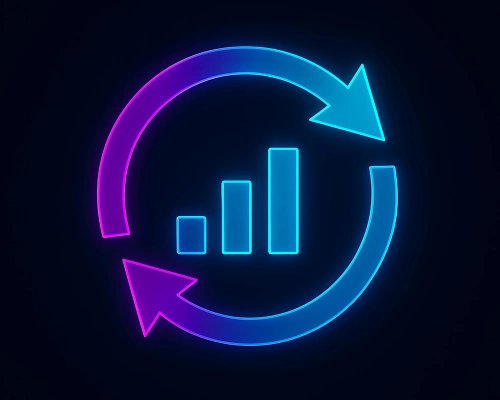Blog Post
Common Marketing Automation Mistakes and How AI Fixes Them
- Update
- Read Time: 8 Min
Share

Marketing automation is supposed to make life easier, saving time, increasing efficiency, and driving better results. But for many businesses, automation ends up doing the opposite. Why? Because they fall into avoidable traps that hurt click-through rates, kill engagement, and ruin the customer experience.
Whether you’re using marketing automation tools for email marketing or full-funnel campaigns, avoiding common marketing automation mistakes is key to reaching your strategy’s full potential. Let’s walk through the biggest missteps—and how AI can help your marketing team avoid them.
Relying on Static Email Lists
Outdated, one-size-fits-all email lists are one of the most common marketing automation mistakes. If your automated email campaigns are still going out to the same list you uploaded six months ago, you’re leaving money on the table.
Static lists don’t reflect real-time changes in customer behavior, interest, or engagement. That means your emails may be irrelevant, ignored, or worse, flagged as spam.
AI Solution: Dynamic audience segmentation that evolves in real time. AI-powered marketing automation platforms can segment your contacts based on real-time behavior, like recent purchases, page visits, or engagement with previous emails. This ensures each message feels timely, relevant, and personalized.
Sending Campaigns at the Wrong Time
Timing is everything in marketing automation. Sending a campaign at the wrong hour (or on the wrong day) can tank your open and click-through rates.
Many marketing automation efforts fail because teams rely on gut instinct or outdated rules about send times.

But studies on the importance of send time optimization show that AI-driven timing—analyzing each subscriber’s past behavior—can significantly boost open and click-through rates
Understanding not just when to send, but how to determine the best time to send emails based on subscriber segments can improve engagement, especially when paired with real-time behavior data. What works for one audience or campaign might flop for another.
AI Solution: Predictive send-time optimization based on user behavior. AI marketing automation software can analyze when subscribers are most likely to open and engage with an email. Instead of blasting your list at 9 a.m. on a Tuesday, you can schedule personalized sends at optimal times, boosting engagement and conversion rates.
Lack of Personalization
Generic messages don’t perform well. Today’s consumers expect content tailored to their needs, behaviors, and interests. A “Dear Valued Customer” email won’t cut it.
Failing to personalize your marketing campaign is a common mistake that impacts customer experience and kills conversions.
AI Solution: AI-driven content that adapts to user intent and purchase stage. Modern marketing automation tools use AI to personalize not just names, but also messaging, product recommendations, subject lines, and even visuals based on past interactions and predicted behaviors.
No Lead Scoring or Qualification
Marketing teams often pass every lead to sales, regardless of how ready that lead is. Without proper qualification, your sales reps waste time chasing poor leads.
This is one of the biggest marketing automation mistakes to avoid if you’re serious about scaling.
AI Solution: Machine learning algorithms that rank and prioritize leads. AI can assess lead behavior across channels (email clicks, landing page visits, webinar attendance) to assign scores. This way, your marketing team focuses on nurturing while sales pursues high-intent leads.
Ignoring Post-Campaign Data

Many teams “set and forget” their marketing automation strategy.
But data from your campaigns—click-through rates, bounce rates, and conversions offers critical insights.
Ignoring this data is a missed opportunity to optimize future efforts and improve customer experience. Businesses that implement AI for market research often uncover patterns and behaviors they would’ve otherwise missed, leading to sharper strategy and better ROI.
AI Solution: AI-powered analytics that detect trends and suggest optimizations. AI tools can scan campaign performance to identify what’s working, what’s not, and what to test next. They help marketing teams make smarter, data-driven decisions without spending hours digging through reports.
Over-Automating Without Strategy
Automation for automation’s sake is a trap. Bombarding your audience with too many emails or messages can feel robotic and impersonal. Worse, it can erode trust.
Using marketing automation software without a clear plan is a common mistake that creates noise instead of results.
AI Solution: Balance automation with human oversight using smart triggers. An effective marketing automation strategy uses AI to trigger actions based on intent, not volume. Smart automation lets you react to meaningful behavior (like abandoning a cart or downloading a guide) without overwhelming the user.
The Cost of Getting It Wrong
Marketing automation can save money and boost efficiency only when used correctly. The cost of missteps includes wasted ad spend, low conversion rates, poor customer experiences, and even long-term damage to your brand’s reputation.
Misaligned messages or excessive automation can cause customers to opt out permanently, and flawed data only compounds the problem. Applying Deming’s principle shows it can cost $1 to prevent, $10 to correct, or $100 if left unaddressed, meaning the true cost of bad data in your marketing automation may be draining far more than you realize.
The longer these issues go unchecked, the harder they are to correct. A flawed automation system can snowball into poor campaign performance across the board.
Using marketing automation software without a clear plan is a common mistake that creates noise instead of results.
AI Solution: Balance automation with human oversight using smart triggers. An effective marketing automation strategy uses AI to trigger actions based on intent, not volume. Smart automation lets you react to meaningful behavior (like abandoning a cart or downloading a guide) without overwhelming the user.
Aligning Automation with Customer Journey Stages
Another common mistake? Using the same automation tactics across every stage of the funnel. A top-of-funnel prospect needs education, not a hard sell. Mid-funnel leads need nurturing, not the same promo emails sent to loyal buyers.
Mapping automation to the customer journey—awareness, consideration, decision—ensures your marketing automation efforts increase engagement instead of causing drop-off.
When automation is aligned with intent and behavior, it improves not just conversions but also the customer experience across channels.
The Human Element Still Matters
Automation is powerful, but it shouldn’t replace the human side of marketing. One of the most overlooked aspects of successful marketing automation efforts is the emotional connection between brand and customer.
Relying solely on automation tools to build relationships can lead to tone-deaf messages and an impersonal brand voice.

AI can help with tone analysis and intent detection, but humans still bring the creative, emotional intelligence that drives trust and loyalty. Don’t let automation become a crutch—use it as a co-pilot, not the entire crew.
Evaluating the Right Marketing Automation Platform
Not all marketing automation software is created equal. A common mistake many businesses make is choosing a tool that doesn’t align with their goals, team capabilities, or audience size.
If your platform lacks flexibility, integration options, or proper analytics features, it could be holding back your marketing campaign performance.
When evaluating platforms, look for:
- Scalability to support growth
- Integration with your CRM and data tools
- User-friendly dashboard for reporting
- AI features for smarter decision-making
Choosing the right marketing automation platform is just as important as how you use it. The wrong software can create bottlenecks, silo your data, and limit your ability to increase engagement across channels.
Building a Feedback Loop for Continuous Improvement
Marketing automation isn’t a “set it and forget it” process. Your team should continuously test, analyze, and refine workflows based on customer behavior and data.
Creating a feedback loop—where performance data informs future strategies—helps ensure your automation evolves as your business and audience do.

Feedback loops can include A/B testing, engagement tracking, and campaign audits. These insights allow for incremental improvements that drive sustainable results, something our AI marketing agency specializes in helping businesses build into their strategy.
How to Avoid These Mistakes with an AI Marketing Partner
The truth is, marketing automation tools are only as good as the strategy behind them. Without the right setup, even the best platforms will underdeliver. That’s where working with an AI-powered marketing agency makes the difference.
If you’re wondering why so many companies are shifting this way, explore why business owners are partnering with an AI agency to streamline results and stay competitive.
An AI marketing partner can help you:
- Design smarter, data-driven workflows
- Create personalized campaigns that boost engagement
- Use predictive analytics to improve timing and messaging
- Continuously optimize based on performance insights
- Integrate your tools into a seamless, strategic system
When done right, marketing automation drives better results with less manual effort. But avoiding common mistakes is essential, and AI makes it easier than ever to get it right.
Written by
Reisinger Strategies Group Team
Reisinger Strategies Group helps businesses grow with AI-powered marketing solutions, from strategy to execution and built to drive real results.



